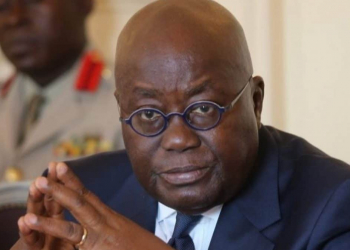Banks are paying an average of 11.9 per cent per annum as interest on deposits but charging their borrowers an average of 33.4 per cent as nominal interest on loans annually, data from the Bank of Ghana (BoG) on the annual percentage rates (APRs) and Average Interest (AI) of banks has shown.
While interest on deposits ranges from 4.3 per cent to 19.5 per cent, the APRs of the 31 banks surveyed by the Central Bank showed that interest and administrative charges on loans hovered between 20.3 per cent and 46.2 per cent within the survey period.
The 46.2 per cent is the highest annual interest plus administrative or service charges that a borrowing customer will pay on a loan facility taken before January 31, this year, according to the data released in the week ending February 17.
As an aggregate of interest on loans and deposits in the country, the wide spread in the APRs and AI bring to the fore the yawning disparity that exists between returns on savings or deposits and the cost of credit in the banking sector.
Despite successfully mobilising cheaper funds through deposits (bank deposits totalled GH¢51.4 billion compared to a loan book of GH¢35.5 billion as of December 2016), the cost of bank credit continues to be high in the country, mainly due to the increasing risks of default, lack of long-term and low cost funds and the unstable macroeconomic environment.
The Managing Director (MD) of Stanbic Bank, Mr Alhassan Andani, attributed the development to a myriad of factors, including the high numbers of transactional bank deposits in the country.
While admitting that the spread between the APRs and AI “is pretty high,” Mr Andani, who doubles as President of the umbrella body of banks in the country — the Ghana Association of Bankers (GAB) — told the GRAPHIC BUSINESS on February 26 that a chunk of bank deposits emanated from current account deposits, which are mostly short term in nature and, therefore, zero per cent interest bearing.
Dilution Bank deposits are generally categorised into three — current account (which are transactional), savings accounts and fixed term accounts or placed funds.
Although some deposits, mostly fixed term or placement deposits, attract interest rates as high as Treasury bill rates plus two per cent, their effect has been diluted by the sizeable nature of transactional accounts in the basket.
Given that customers of such accounts virtually withdraw their deposits on daily basis, the Stanbic Bank MD explained that banks normally do not have the luxury of time to invest such funds on behalf of their clients to earn handsome interest, part of which could have been paid to the customer.
“The investment value of those current accounts, which are transactional in nature, tend to be zero because the bank does not know when the depositor will come for the money,” he said.
“In general, deposit interest rates range from treasury bill plus two per cent all the way to current account balances, which are zero. The dilution factor in all of this is the current account; the current account balances are very large yet the investment return on them is very low because you (the bank) do not know when the customer will come for the money.”
“So, when you add the interest on all these deposits and you take an average, as BoG does, then you have that low deposit interest rate,” Mr Andani explained.
Correcting the curve
While admitting that the spread between APRs and AI was high, Mr Emmanuel Asiedu-Mante, who retired as deputy Governor of the BoG in 2006, said the situation was a reflection of the profit-obsessed nature of banks and the lack of increased competition, which could have helped to drive down cost. “Bankers are not different from the guy selling yam or tomatoes at Makola.
Banks do the same thing; they buy money from you and me, when we deposit our savings because they pay some minimal interest on those deposits,” he told the GRAPHIC BUSINESS on February 21.
“Now, that money does not sit in the vault of the banks; it is lent to borrowers, be they businesses or individuals. So, the banks pay you, maybe six per cent on your savings account deposit and they lend it at 25 per cent or something like that. The difference between the six per cent and the 25 per cent is the gross margin,” Mr Asiedu-Mante added.
This margin, he said, was then used to cover the expenses of running the bank while remunerating shareholders. “Banks trade money; they buy money and they sell money and they make profit. What we can probably say is that the gap is too wide, which I agree, but you cannot legislate it; you can only create a lot of competition in the industry to help narrow the gap,” he said.
He recounted the situation when in the early 2000s, banks required some amount of money as minimum balance to qualify a prospective customer to open an account. That practice, he said, had now been scrapped, thanks to the influx of banks that now virtually compete for the same customer.
“Yes, we have about 34 banks, over 100 rural banks, savings and loans companies and finance houses, but they are all operating. What it means is there is still a large pool of people who are yet to be banked,” he said, referring to the country’s unbanked population, estimated to be about 70 per cent of the adult population.
“We haven’t reached the saturation point or the point where banks are collapsing because they are not getting customers.
When we get to that point, some of these things will self-correct themselves,” he added.
Interest rate build-up
For years, access to and cost of credit has topped the list of challenges facing businesses in the country. The Association of Ghana Industries (AGI’s) quarterly news bulletin, the Business Barometer Index (BBI), continues to flag the two factors among the list of three challenges affecting industrial growth, with many bankers blaming it on the fiscal slippages in the country.
Given that high inflation and fiscal deficits impact directly on bank rates, most bankers argue that keeping large deficits, as has been the case with Ghana in recent years, normally translates into an increased non-performing loans (NPLs) ratio, which is then factored into the interest rate build-up.
“The loan interest rate is the nominal interest rate in your deposit cost plus an average amount of bad loans because you’ve got to recover somehow, some loans that you’ve given which won’t come back.”
“So, there is some element of non-performing loan percentage which sets in in the interest rate structure. So, in a market where NPLs are very high, the contribution of the NPLs to the interest rate can be very high,” Mr Andani said.
From 11.4 per cent in March, 2015, the NPL ratio peaked at 19.3 per cent in May 2016 before easing to 17.4 per cent in December, the same year. Beyond NPLs, the Stanbic Bank MD explained that interest rates on loans were also a factor of the cost of operations of banks.
“So, it is not that kind of a straight line pricing on loan interest rates, but having said that the question is: ‘What is your spread?”. He commended the BoG for publication of the APRs and the API as one strategy that could help shed more light on the pricing regime of banks to help rationalise the numbers
Join GhanaStar.com to receive daily email alerts of breaking news in Ghana. GhanaStar.com is your source for all Ghana News. Get the latest Ghana news, breaking news, sports, politics, entertainment and more about Ghana, Africa and beyond.


